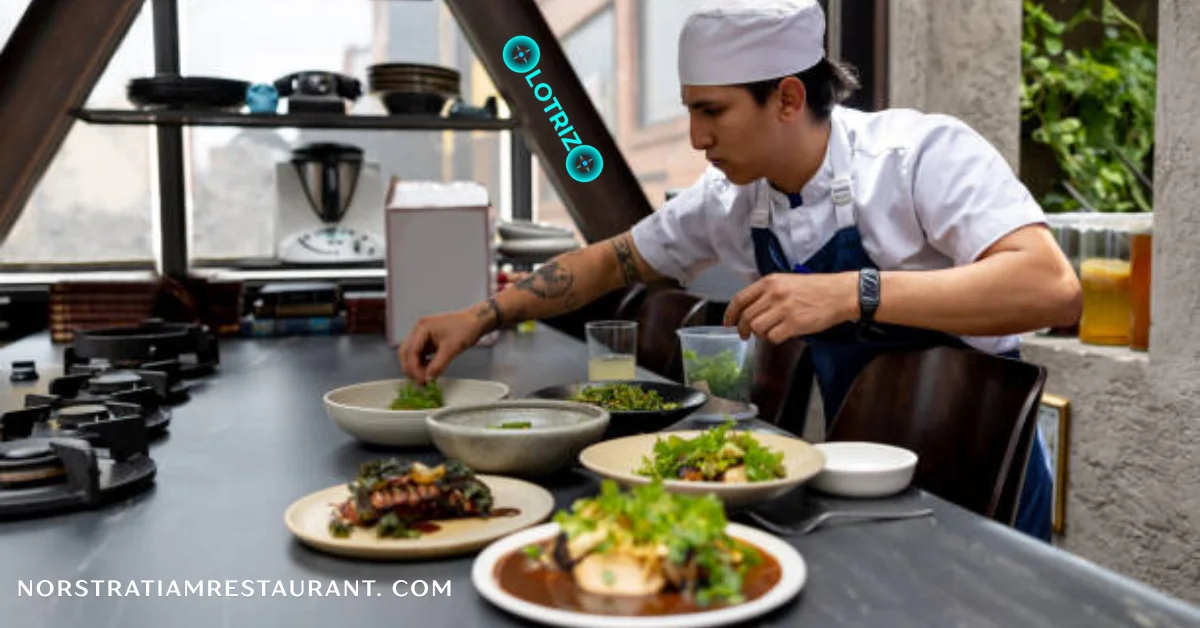Food & Drinks
Giniä Traditional Food: A Tapestry of Taste and History

Introduction to Giniä Traditional Food
Giniä traditional food is more than just a meal; it’s a vibrant tapestry woven with rich history, culture, and flavor. Each dish tells a story that transcends generations, making every bite an experience in itself. When you delve into Giniä cuisine, you’re not merely tasting ingredients—you’re immersing yourself in the traditions of the Giniä people. From hearty staples to aromatic spices, this culinary journey invites you to explore what makes Giniä so unique. Join us as we uncover the essence of Giniä traditional food and discover why it continues to enchant palates around the world.
The History and Culture Behind Giniä Cuisine
Giniä cuisine is a vibrant reflection of its rich history and diverse culture. Rooted in ancient traditions, it showcases the influences of various civilizations that have crossed paths over centuries.
The agricultural landscape plays a crucial role in defining Giniä food. Local farmers cultivate staple crops, embodying generations of knowledge passed down through families. This connection to the land fosters community bonds and preserves cultural heritage.
Many dishes tell stories of celebrations and rituals. Food often becomes central during festivals, highlighting regional variations that add depth to the culinary experience.
Culinary practices are intertwined with customs and social gatherings, creating opportunities for sharing stories around communal tables. Each bite offers a taste not just of flavor but also identity—a celebration of resilience through changing times while honoring ancestral roots.
Staple Ingredients in Giniä Dishes
Giniä cuisine captivates the taste buds with bold flavors and diverse textures, centered around key ingredients that shape its identity.
Grains like millet and sorghum serve as foundational elements in many dishes. These provide not only sustenance but also a distinct taste that pairs beautifully with various accompaniments.
Vegetables play a starring role, too. Fresh produce such as tomatoes, greens, and root vegetables add color and nutrition to meals. They are often sourced from local gardens or markets.
Spices enhance Giniä dishes, adding depth, warmth, and intricate layers of flavor. Ingredients like ginger, garlic, and chili bring depth to every bite.
Proteins—whether from beans or meats—round out dishes perfectly. Each ingredient contributes to a harmonious balance of flavor that makes Giniä cuisine truly remarkable.
Popular Giniä Dishes and Their Meanings
Giniä cuisine boasts a variety of dishes, each rich in flavor and steeped in cultural significance. One popular dish is **Sankara**, a hearty stew made with local vegetables and spices. It symbolizes community and togetherness, often enjoyed during gatherings.
Another staple is **Kaji**, a savory porridge that represents nourishment and comfort. Traditionally served for breakfast, it’s known to energize families for the day ahead.
**Mala**, sweetened rice cakes filled with fruits or nuts, evoke celebration. These treats are often prepared during festivals, showcasing creativity and joy.
Every Giniä dish narrates a tale of tradition, strength, and how food brings people together. Through every bite, diners can connect with centuries of tradition. The meanings behind these meals offer insights into what sustains not just bodies but also spirits within Giniä culture.
How Giniä Traditional Food is Prepared and Served
Giniä traditional food is a labor of love, rooted in ancient practices and communal spirit. Preparation often begins with selecting the freshest ingredients from local markets. Residents cherish their ingredients, confident that superior quality means better flavor.
Cooking methods vary widely but usually involve techniques such as slow-cooking, steaming, or grilling over open flames. These methods not only enhance flavors but also preserve nutritional value.
Serving Giniä dishes is an experience in itself. Meals are typically enjoyed family-style, fostering connection among diners. Large platters adorned with colorful foods invite everyone to share and participate.
Traditional presentations may include decorative garnishes made from herbs and spices. This attention to detail reflects the artistry inherent in Giniä cuisine—a true feast for the senses where flavor meets history on every plate.
Health Benefits of Giniä Cuisine
Giniä cuisine offers a delightful array of health benefits, thanks to its emphasis on fresh, local ingredients. Many dishes are rich in vegetables and legumes, which provide essential vitamins and minerals.
The use of spices not only enhances flavor but also contributes various health advantages. For instance, turmeric is known for its anti-inflammatory properties while garlic can boost the immune system.
Moreover, Giniä meals often incorporate whole grains. These fibers aid digestion and promote heart health. The balance of protein from beans or lentils supports muscle repair and overall well-being.
Eating Giniä food encourages mindful consumption. Dishes are often served family-style, promoting social interaction during mealtime—a great way to nourish both body and spirit.
Where to Experience Giniä Traditional Food
If you’re eager to dive into the rich flavors of Giniä traditional food, several places await your discovery. Start with local markets; they often teem with authentic dishes made right in front of you.
Restaurants specializing in regional cuisine provide an immersive experience. Here, chefs pour their heart into age-old recipes that reflect Giniä’s heritage.
For a more intimate setting, seek out family-owned eateries. These gems often serve secret family recipes passed down through generations, offering a taste of tradition that feels personal and heartfelt.
Festivals celebrating Giniä culture are another fantastic opportunity. Food stalls at these events showcase the diversity and vibrancy of local dishes while allowing for community interaction.
Consider joining cooking classes too. Many offer hands-on experiences where participants can learn about ingredients and techniques central to Giniä cuisine while enjoying delicious results!
Conclusion: Keeping the Tradition Alive Through Food
Food goes beyond nourishment; it serves as a link uniting generations, cultures, and histories. Giniä traditional food embodies this essence beautifully. Through its rich flavors and time-honored recipes, Giniä cuisine keeps the stories of ancestors alive.
Every dish tells a tale of the land, the people, and their way of life. By preserving these culinary traditions, we honor those who came before us while sharing something valuable with future generations. This cultural tapestry woven through taste invites everyone to partake in an experience that goes beyond mere eating.
As you savor each bite of Giniä food, remember that you’re not just enjoying a meal but participating in an age-old ritual steeped in history and significance. Embrace this opportunity to explore new tastes while keeping the spirit of Giniä vibrant and thriving for years to come.
Food & Drinks
B09LKRYPGW: Premium Chocolates to Impress Any Chocolate Lover

Introduction to B09LKRYPGW chocolates
If you’re on the hunt for the perfect treat to dazzle a chocolate lover, look no further than B09LKRYPGW chocolates. These premium delights are not just any ordinary sweets; they represent a harmonious blend of craftsmanship and flavor that can turn an everyday snack into an extraordinary experience. Whether you’re celebrating a special occasion or simply indulging in life’s little pleasures, these chocolates will impress anyone fortunate enough to savor them. Get ready to dive into the rich history, unique flavors, and health benefits of B09LKRYPGW chocolates your taste buds are about to embark on an unforgettable journey!
The history and production process of B09LKRYPGW chocolates
The journey of B09LKRYPGW chocolates begins with the finest cacao beans sourced from sustainable farms. These beans are handpicked, ensuring only the highest quality makes it to production.
Once harvested, the beans undergo fermentation and drying—a crucial step that develops their rich flavor profile. Afterward, they’re meticulously roasted to unlock deep notes of chocolate goodness.
Crafting B09LKRYPGW chocolates involves blending these roasted beans into a velvety smooth chocolate mass. This process is an art form in itself, as chocolatiers skillfully combine different ingredients to create unique textures and flavors.
Confectioners take great care during tempering; this technique ensures the chocolate has a glossy finish and a satisfying snap when broken. Each piece is then molded into exquisite shapes before being cooled for packaging.
This meticulous attention to detail reflects in every bite of B09LKRYPGW chocolates, making them a true delight for any chocophile.
Unique flavors and ingredients used in B09LKRYPGW chocolates
B09LKRYPGW chocolates are a treasure trove of unique flavors. Each bite offers an exploration of taste that goes beyond traditional chocolate.
Imagine the richness of dark chocolate blended with zesty orange and aromatic cardamom. This combination tantalizes the palate, creating a delightful contrast between sweet and spicy.
Another standout is the creamy milk chocolate infused with Himalayan sea salt. The salty notes elevate its sweetness, making each piece an irresistible treat.
For adventurous souls, there’s lavender-infused white chocolate a floral twist that surprises and delights those who try it.
These innovative ingredients highlight B09LKRYPGW’s commitment to quality and creativity in every creation. They invite you on a sensory journey, celebrating both classic tastes and daring combinations that keep chocolate lovers coming back for more.
Health benefits of consuming B09LKRYPGW chocolates in moderation
B09LKRYPGW chocolates not only satisfy your sweet tooth but also offer some surprising health benefits when consumed in moderation. Rich in antioxidants, they can help combat free radicals in the body. This means better protection against oxidative stress and various diseases.
Dark chocolate varieties often found within B09LKRYPGW are known for their heart-healthy properties. They can improve circulation and lower blood pressure due to flavonoids that enhance cardiovascular function.
Moreover, indulging every now and then can elevate mood. The pleasure derived from rich chocolate stimulates the release of endorphins, creating a sense of happiness.
It’s important to savor these treats mindfully. Enjoying just a few pieces can keep cravings at bay while allowing you to relish the complex flavors without overindulgence. Balance is key; this way, you reap the benefits without compromising your wellness journey.
How to properly store and enjoy B09LKRYPGW chocolates?
Storing B09LKRYPGW chocolates properly enhances their flavor and texture. Store them in a dry, cool area, avoiding any exposure to direct sunlight. Ideal temperatures are between 60°F to 70°F (15°C to 21°C).
Avoid the fridge if possible; humidity can lead to undesirable changes in taste and appearance. If you must refrigerate, seal the chocolates tightly in an airtight container to prevent moisture absorption.
When it’s time to indulge, let your B09LKRYPGW chocolates sit at room temperature for about 10 minutes before savoring. This allows the rich flavors to develop fully.
Pair these exquisite treats with complementary beverages like red wine or gourmet coffee for an elevated experience. Pay attention to serving size; just a few pieces can satisfy cravings while keeping indulgence moderate and enjoyable.
Gifting ideas for chocolate lovers with B09LKRYPGW chocolates
Finding the perfect gift for a chocolate lover can be a delightful challenge. B09LKRYPGW chocolates make an exquisite choice that is sure to impress.
Consider creating a curated gift basket filled with these premium chocolates. Pair them with gourmet coffee or fine wine for an indulgent treat.
For special occasions, opt for elegant packaging. A beautifully wrapped box of B09LKRYPGW chocolates adds a touch of sophistication and excitement.
You might also think about personalizing your gift. Include a heartfelt note or select flavors that resonate with their taste preferences.
Alternatively, plan a chocolate tasting night featuring various B09LKRYPGW varieties. This interactive experience allows friends and family to explore new flavors together while enjoying quality time.
No matter how you choose to present them, B09LKRYPGW chocolates are bound to bring joy and satisfaction to any chocolate aficionado on your list.
Conclusion
B09LKRYPGW chocolates stand out as a luxurious and delicious treat that can captivate any chocolate lover’s heart. With their rich history, meticulous production process, and unique flavors, they offer something truly special.
These premium chocolates not only please the palate but also come with health benefits when enjoyed in moderation. Proper storage ensures these delectable creations maintain their quality, allowing you to fully appreciate each bite.
As gifting options for friends or family looking to indulge in something extraordinary, B09LKRYPGW chocolates are an excellent choice. They convey thoughtfulness and sophistication in every box.
Whether you’re treating yourself or someone else, exploring the world of B09LKRYPGW is sure to enhance your chocolate experience. Dive into this exquisite realm of flavor and enjoy all that it has to offer.
Food & Drinks
NorstratiamRestaurant. com: Redefining Global Digital Dining

Introduction to NorstratiamRestaurant. com
Welcome to the future of dining! NorstratiamRestaurant.com is here to transform how you experience meals from around the world. Imagine enjoying exquisite cuisine without stepping out of your home, all while connecting with diverse cultures and culinary traditions. This innovative platform harnesses technology to create a seamless digital dining experience that caters to food lovers everywhere. Whether you’re craving exotic flavors or local favorites, NorstratiamRestaurant.com promises something special for everyone. Get ready to embark on a journey where taste knows no boundaries and every meal tells a story.
The Concept of Digital Dining and its Benefits
Digital dining is revolutionizing how we experience food. The integration of technology into the dining scene creates a seamless connection between customers and their favorite cuisines.
One significant benefit lies in convenience. With just a few clicks, diners can explore diverse menus from various local restaurants without leaving home. No more waiting in line or dealing with crowded spaces.
Flexibility is another advantage. Customers can choose when and where they want to dine, making it easier to fit meals into busy schedules.
Moreover, digital dining fosters exploration. It encourages people to try new dishes and flavors that may not have been on their radar before.
By embracing this modern approach, everyone wins—customers satisfy cravings while supporting local businesses at the same time. This dynamic shift is reshaping culinary experiences for the better.
How NorstratiamRestaurant. com Works?
Navigating NorstratiamRestaurant.com is a seamless experience for users. The platform allows diners to explore diverse cuisines from the comfort of their homes.
Upon visiting, customers can browse through an extensive menu curated by partnering local restaurants. Each dish comes with vivid imagery and detailed descriptions to entice your taste buds.
Ordering is straightforward. Just select your meal, customize it if needed, and proceed to checkout using secure payment options.
Real-time updates keep you informed about your order status—no more guessing when dinner will arrive.
Additionally, the site features user reviews and ratings that help in making informed choices based on previous customer experiences.
With just a few clicks, you’re connected to a world of flavors ready for delivery at your doorstep or available for pickup at nearby locations.
Unique Features and Offerings of NorstratiamRestaurant. com
NorstratiamRestaurant.com stands out with its innovative approach to dining. The platform offers a unique virtual experience that transports diners around the world, allowing them to explore diverse cuisines from the comfort of their homes.
One of its standout features is an interactive menu system. Diners can customize their orders through a user-friendly interface, selecting preferences and dietary restrictions seamlessly.
Moreover, live cooking sessions hosted by renowned chefs add an engaging twist. Customers are not just passive observers; they participate in culinary adventures while preparing meals alongside professionals.
The integration of augmented reality brings dishes to life on-screen, showcasing vibrant presentations and detailed ingredient sourcing information. This feature enhances understanding and appreciation for each meal served.
Additionally, NorstratiamRestaurant.com emphasizes community involvement by featuring local artists and musicians during virtual events, creating a holistic dining atmosphere that celebrates culture beyond food alone.
Partnering with Local Restaurants and Promoting Cultural Diversity
NorstratiamRestaurant.com is dedicated to celebrating the rich tapestry of global cuisines. By partnering with local restaurants, it creates a vibrant platform that showcases diverse culinary traditions.
Every collaboration aims to bring authentic flavors directly to diners’ tables. This not only enhances the dining experience but also supports local chefs and communities. Each dish tells a story, rooted in culture and history.
Local partnerships allow NorstratiamRestaurant.com to introduce customers to unique ingredients and cooking techniques. Diners can explore dishes they might never have tried otherwise, expanding their palates in delightful ways.
Moreover, these collaborations foster understanding and appreciation among different cultures. Food becomes a bridge that connects people from various backgrounds—encouraging dialogue and shared experiences around the table.
By promoting cultural diversity through food, NorstratiamRestaurant.com redefines how we enjoy dining while nurturing community ties at its core.
Enhancing Customer Experience through Technology
Technology is transforming the dining landscape. At NorstratiamRestaurant.com, this evolution takes center stage. Customers can browse menus and place orders seamlessly from their devices.
Interactive features enhance engagement, making each meal an experience rather than just a meal. Personalized recommendations based on past choices create tailored dining experiences that keep patrons coming back.
Real-time updates on order status eliminate uncertainty and elevate anticipation for the next bite. Plus, integrated feedback systems allow diners to share their thoughts instantly, ensuring restaurants adapt quickly to customer preferences.
Innovations like augmented reality menus offer a glimpse into what’s being served, adding another layer of excitement to the dining journey. With these advancements, NorstratiamRestaurant.com is not just about food; it’s about creating lasting memories through cutting-edge technology designed with customers in mind.
Sustainability and Environmental Responsibility
Sustainability is at the heart of NorstratiamRestaurant.com’s mission. The platform prioritizes eco-friendly practices, creating a ripple effect throughout the dining experience.
By partnering with local farms and suppliers, it reduces food miles and supports sustainable agriculture. This approach not only boosts local economies but also minimizes carbon footprints.
The use of digital menus further cuts down on paper waste. Diners can explore diverse cuisines without contributing to unnecessary environmental harm.
Additionally, NorstratiamRestaurant.com actively encourages restaurants to adopt green practices like composting and energy-efficient appliances. Every dish served reflects a commitment to preserving our planet for future generations.
This dedication extends beyond food sourcing; it encompasses packaging choices too. By promoting biodegradable materials, they ensure that every meal leaves a minimal footprint on the environment.
Through these initiatives, NorstratiamRestaurant.com aims to inspire consumers and restaurants alike in fostering an eco-conscious dining culture.
Expansion Plans and Future Goals
NorstratiamRestaurant.com is poised for remarkable growth in the coming years. With a commitment to redefining digital dining, the platform plans to expand its services into new markets. This means more diverse culinary experiences from around the globe.
The team envisions partnerships with local restaurants in various regions. By doing so, they aim to showcase authentic flavors while supporting small businesses. Each new collaboration enriches their offerings and strengthens community ties.
Future goals include integrating advanced technology for an even smoother user experience. Imagine AI-driven recommendations tailored just for you or virtual reality tours of partner kitchens before placing your order.
Moreover, NorstratiamRestaurant.com seeks to amplify its sustainability initiatives by collaborating with eco-friendly suppliers and minimizing waste across operations. Such strategies not only elevate dining but also contribute positively to our planet’s health.
Conclusion: A New Era in the Restaurant Industry
The emergence of NorstratiamRestaurant.com marks a significant shift in the restaurant industry. By embracing digital dining, they offer convenience and accessibility to food lovers everywhere. This platform is not just about ordering meals; it’s about creating a vibrant community that celebrates global cuisines.
As technology advances, so does the way we experience dining. NorstratiamRestaurant.com enhances customer interactions through innovative features that make each meal an event to remember. Partnering with local restaurants ensures that every dish served carries cultural significance while promoting culinary diversity.
Sustainability remains at the forefront of their mission, highlighting their commitment to environmental responsibility without compromising on taste or quality. With ambitious expansion plans on the horizon, they are poised to redefine how people engage with food across various regions.
NorstratiamRestaurant.com isn’t simply changing how we order food; it’s pioneering a new era in dining where culture, technology, and sustainability come together seamlessly.
Food & Drinks
Trurimesu: A Distinctive Name Driving Curiosity and Innovation

Introduction to trurimesu
In a world brimming with ordinary names and conventional brands, trurimesu emerges as a breath of fresh air. This distinctive name is not just a label; it’s an invitation to explore something innovative and intriguing. As curiosity piques around what trurimesu represents, the essence of its identity beckons us to delve deeper. What lies beneath this unique moniker? In this blog post, we will unravel the layers of meaning behind trurimesu and discover how it captures attention in today’s fast-paced business environment. Prepare for an enlightening journey that showcases the power of creativity in naming and branding!
What is Trurimesu?
Trurimesu is more than just a name; it embodies innovation and creative spirit. It represents a fresh approach to business, blending modern ideas with tradition.
At its core, Trurimesu signifies an intersection of authenticity and enthusiasm. This unique term sparks curiosity among consumers and entrepreneurs alike. With each syllable, it hints at something special waiting to be discovered.
The essence of Trurimesu lies in its ability to evoke imagination. It encourages people to think outside the box while fostering connections that go beyond superficial interactions.
In various industries, Trurimesu stands as a beacon for those seeking originality. Whether in tech or lifestyle sectors, this distinctive name invites exploration and experimentation.
The Meaning Behind the Name
The name “Trurimesu” evokes a sense of curiosity and intrigue. It’s not just a word; it carries weight and depth. At first glance, one might wonder about its origins.
Breaking down the syllables reveals layers of meaning. The prefix “truri” suggests authenticity or truth, while “mesu” hints at something sweet or delightful. Together, they create an impression of genuine pleasure.
This unique combination invites exploration. It encourages people to dig deeper and understand what lies behind the brand’s identity. This aspect can be incredibly powerful in marketing, as consumers often connect more with names that tell a story.
Moreover, Trurimesu stands apart from conventional names that blend into the background. Its distinctiveness makes it memorable and impactful a strong foundation for any business endeavor aiming to innovate and engage audiences effectively.
How Trurimesu Stands Out in the Business World?
Trurimesu captures attention immediately. Its unique name piques curiosity and invites exploration. In a saturated market, standing out is essential.
The brand embodies innovation at every level. It embraces creativity not just in its offerings but also in its identity. This differentiates Trurimesu from competitors who play it safe with conventional names.
A distinctive name fosters strong brand recognition. Customers are more likely to remember and recommend a business that has an intriguing title like Trurimesu.
Moreover, the uniqueness of the name sparks conversations. Word-of-mouth marketing thrives on originality, allowing Trurimesu to reach wider audiences effortlessly.
In such a fast-paced environment, companies need more than just great products or services; they require memorable identities that resonate with consumers’ emotions and experiences.
The Benefits of a Unique and Creative Name
A unique and creative name can create an instant connection with your audience. It sparks curiosity and encourages exploration. When people hear a distinctive name like “trurimesu,” they often want to learn more.
Such names are memorable, making it easier for customers to recall your brand. This memorability fosters loyalty, as consumers are likely to return to a name that stands out in their minds.
Moreover, a creative name can set you apart from competitors. In saturated markets, differentiation is key. A unique label can convey the essence of your business or product right away.
Think about brand storytelling; an engaging name allows you to build narratives that resonate with your target audience. This emotional appeal deepens customer relationships and enhances overall engagement with your brand’s mission and values.
Examples of Successful Companies with Distinctive Names
Distinctive names can create a lasting impression and set businesses apart. Consider Apple, which revolutionized technology with its sleek design and user-friendly products. The brand name evokes simplicity, creativity, and innovation.
Another example is Google.Originating from the mathematical term “googol,” it symbolizes the company’s goal of managing enormous quantities of information. This unique name has become synonymous with search engines worldwide.
Then there’s Nike, inspired by the Greek goddess of victory. The name conveys strength and aspiration, aligning perfectly with its athletic brand image.
Think about Airbnb. Short for “Air Bed & Breakfast,” it captures the essence of home-sharing in an engaging way that resonates globally.
Each of these companies demonstrates how a distinctive name not only attracts attention but also builds a strong identity within their respective markets.
Tips for Creating a Memorable and Effective Brand Name
Creating a memorable brand name requires creativity and clarity. Start by brainstorming words that resonate with your vision and values.
Consider simplicity; names that are easy to spell and pronounce tend to stick better in people’s minds. Use unique combinations or made-up words, much like “trurimesu,” which sparks curiosity.
Think about the emotional connection you want your audience to feel. A name should evoke feelings or imagery relevant to your brand’s mission.
Testing is crucial. Share potential names with friends and colleagues for feedback on first impressions.
Check for availability online. Ensure the domain name isn’t taken, as a strong digital presence is vital today.
Conclusion
Trurimesu captivates attention in a world filled with conventional names. It sparks interest and invites questions, pushing boundaries and encouraging innovation. A name like Trurimesu is not just distinctive; it encapsulates creativity and boldness.
Unique branding plays a crucial role in the business landscape today. It can set a company apart from competitors, create lasting impressions, and foster customer loyalty. As demonstrated by other successful businesses that have embraced distinctive names, standing out is essential for growth.
Choosing an innovative name requires thoughtfulness and strategy. Companies should consider their message, target audience, and industry trends when crafting their brand identity. With the right approach to naming, businesses can thrive in even the most crowded markets.
Those who take inspiration from Trurimesu might find themselves on a path toward greater recognition and success a journey defined by curiosity and exploration of what’s possible beyond traditional norms.
-

 Business2 months ago
Business2 months agoContact CrypticStreet.com: Secure and Smart DeFi Trading
-

 Entertainment3 months ago
Entertainment3 months agoهنتاوي.com: Arabic Hub for Anime, Manga, and Pop Culture
-

 General4 months ago
General4 months agoZuschneidfelle: Luxury Leather Born from Art and Tradition
-

 Business4 months ago
Business4 months agoJonathonSpire: SEO & Marketing Tactics That Drive Real Results
-

 Health4 months ago
Health4 months agoDepomin82: Breakthrough Support for Mood and Mental Health
-

 Entertainment4 months ago
Entertainment4 months agoHydraHD Free Movies: Stream HD Films Anytime, Anywhere
-

 Fashion4 months ago
Fashion4 months agoTsunaihaiya: A Cultural Treasure Shaped by Centuries
-

 Business4 months ago
Business4 months agoKonversky Tech: Transforming Data into Business Success





